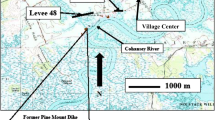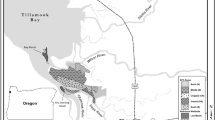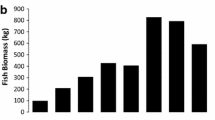Abstract
The performance of two intertidal wetland mitigation projects constructed by the California Department of Transportation (Caltrans) in the Sweetwater Marsh National Wildlife Refuge (SMNWR) in San Diego Bay was evaluated over 5 years. Most of the Sweetwater wetland complex has been altered this century, including diking (with subsequent subsidence), filling, modification of the tidal regime, freshwater inflow and sediment fluxes. The mitigation project goals included a range of functional criteria intended to support two endangered bird species (light-footed clapper rail and California least tern) and one endangered plant (salt marsh bird's-beak). While the mitigation projects have achieved some of the performance criteria established in the regulatory permits (particularly, those related to fish), vegetation criteria for one of the bird species have not been met. The initial grading (in relation to local tidal datums) should support the target plant species, but growth has been less than required. Shortcomings of the habitat include elevated soil and groundwater salinity, low nutrient levels (especially nitrogen, which is readily leached from the coarse substrate), and eroding topography (where a single oversized and overly sinous channel and the lower-than-natural marshpalin result in high velocity surface water flow and erosion). The failure to achieve a large plain at low-marsh elevations highlights the importance of a more complete understanding of the relationship between the site physical processes (topography, hydrology, climate, geomorphology), substrate conditions, and biotic responses.
Similar content being viewed by others
References
Baltz, D.M., Rakocinski, C. and Fleeger, J.W. 1993. Microhabitat use by marsh-edge fishes in a Louisiana estuary. Env. Biol. Fish., 36: 109–126.
Bertness, M.D., Gough, L. and Shumway, S.W. 1992. Salt tolerances and the distribution of fugitive salt marsh plants. Ecol., 73: 1842–1851.
Boyer, K.E. 1994. Scale insect damage in constructed salt marshes: Nitrogen and other factors. M.S. Thesis., San Diego State University. San Diego, California.
Boyer, K.E. and Zedler, J.B. 1996. Damage to cordgrass by scale insects in a constructed salt marsh: effects of nitrogen additions. Estuaries, 19: 1–12.
Coats, R., Williams, P.B., Cuffe, C.K., Zedler, J.B., Reed, D., Watry, S.M. and Noller, J.S. 1995. Design Guidelines for Tidal Channels in Coastal Wetlands. Report Prepared for the U.S. Army Corps of Engineers. Waterways Experiment Station. 45 pp.
Covin, J. D., and Zedler, J.B. 1988. Nitrogen effects onSpartina foliosa andSalicornia virginica in the salt marsh at Tijuana Estuary. California, Wetlands, 8: 51–65.
Haltiner, J.P. 1990. Sweetwater Marsh: Morphology and Tidal Circulation. Report Prepared for Caltrans District 11. U.S. Army Corps of Engineers, San Diego, California 130 pp.
Haltiner, J.P. 1993. Extreme events and coastal wetlands. Proceedings 1993 ASCE International Symposium on Engineering Hydrology, San Francisco, California, July 25–30.
Haltiner, J.P. and Williams, P.B. 1987. Hydraulie desgin in salt marsh restoration. Proceedings National Symposium of Wetland Hydrology. Association of State Wetland Managers, Chicago, IL. Sept. 16–18.
Harvey, T. and Josselyn, M. 1986. Wetlands restoration and mitigation policies: Commnet and reply. Envir. Mgmt., 10: 567–569.
Kuhn, N. 1995. The effects of salinity and soil saturation on plants in the high intertidal marsh. M.S. Thesis. San Diego State University. San Diego, California.
Langis, R., Zalejko, M., and Zedler, J.B. 1991. Nitrogen assessments in a constructed and a natural salt marsh of San Diego Bay. California. Ecol. Appl., 1: 40–51.
Mclvor, C.C., and Odum, W.E. 1988. Food, predation risk, and microhabitat selection in a marsh fish assemblage. Ecol. 69: 1341–1351.
Myrick, R.M. and Leopold, L.B. 1963. Hydraulic Geometry of a Small Tidal Estuary. United States Geological Survey Professional Paper, 422 B.
Pacific Esturrine Research Laboratory (PERL). 1995. Sweetwater Marssh National Wildlife Refuge: Ecosystem Assessment for Mitigation Compliance. Final Report for 1995. California Department of Transportation. San Diego, California.
Paller, M.H. 1994. Relationships between fish assemblage structure and steam order in South Carolina coastal plain streams. Trans. Am. Fish. Soc., 123: 150–161.
Pestrong, R. 1965. The development of drainage patterns on tidal marshes. Stanford University Publiscations Geol. Sci. Vol. X. No. 2 87 pp.
Race, M.S. 1985. Critique of present wetlands mitigation policies in the United States based on an analysis of past restoration projects in San Fransisco Bay. Envir. Mgmt. 9: 71–82.
Race, M.S. and Fonseca, M.S. 1995. Fixing compensatory mitigation: What will it take? Ecol. Appl. 6: 94–101.
Strahler, A.N. 1964. Quantitative geomorphology of drainage basins and channel networks.In: Chow, V.T. (ed.), Handbook of Applied Hydrology, pp 436–476. McGraw-Hill. New York.
Williams, P.B. and Florsheim, J. 1994. Designing the Sonoma Baylands Project. Coast and Ocean, Fall.
Williams, P., Shepherd, A., and Faber, P. 1988. Monitoring a tidal restoration site in San Francisco Bay: The Muzzi Marsh.In: Proceedings of the National Symposium on Wetlands '88: Urban Wetlands and Riparian Habitat Association of State Wetlands Managers. Byrne. New York.
Zedler, J.B. 1983. Freshwater impacts in normally hypersaline marshes. Estuaries. 6: 346–355.
Zedler, J.B. 1993. Canopy architecture of natural and planted cordgrass marshes: Selecting habitat evaluation criteria. Ecol. Appl., 3: 123–138.
Zedler, J.B., Nordby, S., and Kus, B.E. 1992. The Ecology of Tijuana Estuary: A National and Estuarine Research Reserve. NOAA Office of Coastal Resource Management. Sanctuaries and Reserves Division. Washington, D.C.
Zedler, J.B., Principal Author. 1996. Tidal wetland restoration: A scientific perspective and southern California focus. California Sea Grant College System. University of California, La Jolla. California Report No. T. 038.
Author information
Authors and Affiliations
Additional information
Corresponding editor: R.E. Turner
Rights and permissions
About this article
Cite this article
Haltiner, J., Zedler, J.B., Boyer, K.E. et al. Influence of physical processes on the design, functioning and evolution of restored tidal wetlands in California (USA). Wetlands Ecol Manage 4, 73–91 (1996). https://doi.org/10.1007/BF01876230
Received:
Accepted:
Issue Date:
DOI: https://doi.org/10.1007/BF01876230




